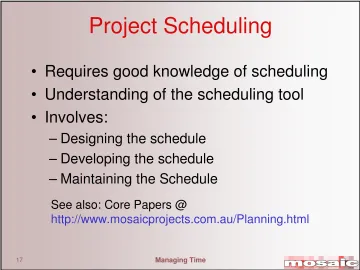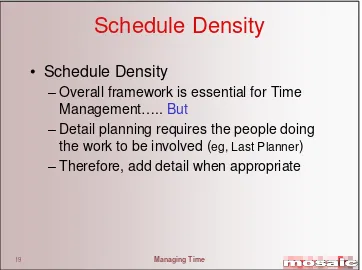Managing Time 1
Delivering Effective Schedules
Through Effective Planning
Patrick Weaver
PMP, PMI-SP, FCIOB. patw@mosaicprojects.com.auOutline
• The static measurement of failure!
•
The Guide
– Project Planning – Project Scheduling
• Developing effective schedules
– Standards
Managing Time 3
Crystal Palace
• We are not
so good!
• Crystal
Palace……
• Built in 1851
Managing Time 5
Crystal Palace
From a rough sketch on blotting paper to the Great Exhibition of 1851 –
How long?
Royal patronage probably helped!!
The Crystal Palace was built in eight and a half months starting on 15 July 1850, opening on 1st May 1851
Burj Khalifa -v- Empire State
Building
The steel frame rose at the rate of
four and a half
Managing Time 7
Building
The steel frame rose at the rate of
four and a half floors per week
Empire State Bldg.
completed in 1931 Burj Khalifa Dubai
208 floors in 5+ years
If the Burj Khalifa in Dubai had been built at the same speed as the Empire State Building it would have
opened two years earlier!
Time -v- Money
• Money – keep until you spend
– Symptom of other successes or failures
• Time – 60 seconds lost every minute
Managing Time 9
Time -v- Money
• Things that don’t work!
– Contract terms and conditions / penalties
• CIOB Report
• UK Government metrics (Constructing Excellence)
– Static contract programs
• Measure failure
• Used for claims and court actions after the event
Time -v- Money
• CIOB – Construction projects
–Managing the Risk of Delayed Completion in the 21st Century
http://www.mosaicprojects.com.au/PDF/CIOB_TM_report_full.pdf
• Gartner ICT projects
Managing Time 11
Skills and Knowledge
• Skills and Knowledge
– Very few skilled planers and schedulers – Not used or respected by management – Except for the fights after the event
• A Brief History of Scheduling
http://www.mosaicprojects.com.au/Resources_Papers_042.html
Skills and Knowledge
• Solutions are being developed
– Definition of good practices
– Development training and certification – Education of management
Managing Time 13
The Guide
• PMI Scheduling
Excellence Initiative
•
Guide to Good Practice
in the Management of
Time in Complex
Projects
• Copies available from:
http://www.mosaicprojects.com.au/Books.html#CIOB_Guide
The Guide
• Planning -v- Scheduling
• Schedule design
• Schedule Density
Managing Time 15
Planning -v- Scheduling
• Project Planning
– Strategic process
– Focus on objectives and methods – Foundation for scheduling
• Project Scheduling
– Develop and maintain an effective schedule
Project Planning
• Precedes Scheduling
• Focuses on methods
and Strategy
Managing Time 17
Project Scheduling
• Requires good knowledge of scheduling
• Understanding of the scheduling tool
• Involves:
– Designing the schedule – Developing the schedule – Maintaining the Schedule
See also: Core Papers @
http://www.mosaicprojects.com.au/Planning.html
Designing the schedule
[image:9.595.117.477.102.372.2]Managing Time 19
Schedule Density
• Schedule Density
– Overall framework is essential for Time Management….. But
– Detail planning requires the people doing the work to be involved (eg, Last Planner) – Therefore, add detail when appropriate
Schedule Density
[image:10.595.118.480.102.372.2]Activities are progressively expanded to greater levels of ‘density’ as more information becomes available
Managing Time 21
Schedule Density
Low-density is appropriate for work, which is intended to take place 12 months, or more in the future.
Tasks may be several months in duration
Medium density is appropriate for work, which is intended to take place between 3 and 9 months after the schedule date. At this stage the work should be designed in sufficient detail to be allocated to contractors, or subcontractors. Task durations should not exceed 2 months.
Schedule Density
High-density scheduling is an essential prerequisite for undertaking work. The schedule is prepared with the people doing the work.
Task durations should be no more than the update cycle
Managing Time 23
Schedule Density
The activity coding structure (ID) maps high to medium to low density
Developing the schedule
• Practical Logic
– Organise the activities into a logical sequence
– Only use ‘real’ activities and logic – Use Finish-Start relationships where
possible
Managing Time 25
Maintaining the Schedule
• Establish a baseline
– At the development stage – As part of a re-baseline
• Record actual progress
• Reschedule from
‘data date’
(or Time Now)Maintaining the Schedule
• Edit for accuracy
– No tool accurately manages all of the issues around partially complete tasks
• Involve both task owners and managers
– Use ‘their data’ not yours!
updates-Managing Time 27
Reporting Options
Data is not information,
information is not knowledge,
knowledge is not understanding,
understanding is not wisdom.
Clifford Stoll
See: Beyond Reporting - The Communication Strategy
http://www.mosaicprojects.com.au/Resources_Papers_094.html
Reporting Options
•
The major challenge
with scheduling is
communicating
complex data
effectively
•
This is achieved
Managing Time 29
Reporting Options
‘Useful’, ‘Accurate’ and ‘Fully Detailed’ are not synonymous and may be contradictory!
Ask for what you need……
Which map is more useful If you are looking for the Dojo
Qualification Framework
This section:
• Current certifications
• Planning Planet
Managing Time 31
Qualification Framework
• Current Qualification Framework
– Association for the Advancement of Cost Engineering International (AACE) PSP – PMI Scheduling Professional (PMI-SP)
• Both focused on highly experienced
schedulers 3 to 5+ years
Qualification Framework
• Limited training for PMI-SP or AACE
– Assumed self study by experts
– Mosaic’s PMI-SP course one of the few available (and in low demand)
• Relatively low numbers of credentials
awarded
Managing Time 33
New Developments
• Planning Planet:
www.planningplanet.com
Planning Planet Accreditation Scheme (PPAS) – Developing training materials
– Developing accreditation process
– Likely to offer industry based qualifications – Entry level certification included
Planning Planet
• PPAS –Standard Documents
– SD 0 Why Plan ?
– SD 1 Planning, Scheduling and Project Control Methods
– SD 2 Designing the Schedule
– SD 3 Creating and Building the schedule – SD 4 Maintaining the Schedule
Managing Time 35
New Developments
• CIOB – Time Management Credentials
– Three levels
– Based on The Guide
– Certificate courses late 2011 – Higher level certifications to follow
The CIOB Framework
Project Time Management Certificate
PTMC is an on-line multiple choice examination with no prerequisites.
Project Time Management Practitioner
PTMP is an assessed credential based on a pass in the PTMC exam and
demonstrated scheduling experience.
Project Time Management Specialist (or Expert)
Managing Time 37
CIOB TM Framework
• Examination specifications under
development
– Certificate no industry bias
– Higher levels Construction industry
• International team (including me)
• CIOB has 190 years of experience as a
professional association
• Australian Region and office
What Mosaic is doing:
• We are developing a free resource at
www.mosaicprojects.com.au/Planning.html
rses f or PM
I and CIOB
Cred entia
Managing Time 39
Conclusion
• Definite trend towards
– Standardising planning and scheduling – Developing training frameworks
– Accrediting Planners and Schedulers
Conclusions
• Solve the ‘chicken and egg’ conundrum
– Well trained schedulers can help project managers and advise senior managers – But no one is training schedulers
Managing Time 41
Conclusions
• We need a management re-education
program
– SOX, etc mandate the need for predictive process like scheduling
– So why do so many projects have time ‘set in stone’ before anyone looks at a realistic schedule?
– Senior managers need to understand the value of skilled schedulers
Conclusions
• International credentials will help
– Focused on new planners and schedulers – Planning Planet & CIOB are in discussion
to normalise or coordinate
•
The Guide
and PMI’s Practice Standard
provide the framework
Managing Time 43
Conclusion
• Challenges:
– Keep training and credentials aligned – Gain respect of management
• We can make a difference!
Useful schedule are useful
because they are used!
Discussion
• Questions please
• Contact details:

